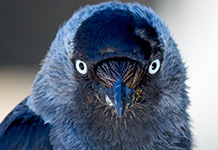
Jackdaws' piercing eyes deter potential intruders. Image courtesy Richard Woods
What the jackdaw saw - study shows birds communicate with their eyes
Researchers in Cambridge and Exeter have discovered that jackdaws use their eyes to communicate with each other – the first time this has been shown in non-primates.
While what humans do with their eyes has been well studied, we know almost nothing about whether birds communicate with members of the same species with their eyes.
The new study, published today in Biology Letters, shows that jackdaw eyes are used as a warning signal to successfully deter competitors from coming near their nest boxes.
Gabrielle Davidson of the University of Cambridge, who led the study, said: “Jackdaw eyes are very unusual. Unlike their close relatives, the rooks and crows – which have very dark eyes – jackdaw eyes are almost white and their striking pale irises are very conspicuous against their dark feathers.”
While most birds have black or dark brown eyes, bright eyes are not unknown in the avian world, and around 10% of passerines (perching birds) have coloured irises.
Just before the spring breeding season arrived last year, the researchers installed one of four different pictures in 100 jackdaw nest boxes. The pictures were either black (the control), a pair of jackdaw eyes, a pair of jackdaw eyes in a jackdaw’s face, or a jackdaw’s face with a pair of black rook eyes. They then filmed the effect the different pictures had on the birds’ behaviour.
After analysing 40 videos of jackdaws peeking into each other’s nest boxes, they found that compared with the other nest boxes, those that contained the picture of a jackdaw with its bright eyes was much more likely to deter the birds from landing on it, and that the birds spent less time near such a nest box.
The study is the first to show the eyes being used as a means of communication between members of the same species outside primates.
The field research took place as part of the Cambridge and Falmouth Jackdaw Projects, which were established by Dr Alex Thornton of the University of Exeter.
Dr Thornton, of the Centre for Ecology and Conservation on the Penryn Campus, said: “Our research on jackdaws in Cornwall and Cambridge is revealing the many subtle forms of communication these birds use to manage the challenges of their busy social lives. This study shows that jackdaws’ distinctive eyes aren’t just an attractive feature – they also serve an important function. Because jackdaws nest in holes like tree cavities, nest-boxes and chimneys rather than building nests like their relatives in the crow family, they have to compete to acquire and defend good nesting sites. By staring out from a cavity with their conspicuous pale eyes they can provide a clear signal, like an ‘occupied’ sign on a public lavatory, to deter potential intruders from approaching and so avoid having to fight. This raises the question of whether other cavity-nesting birds may signal with their eyes in a similar way.”
Date: 5 February 2014
